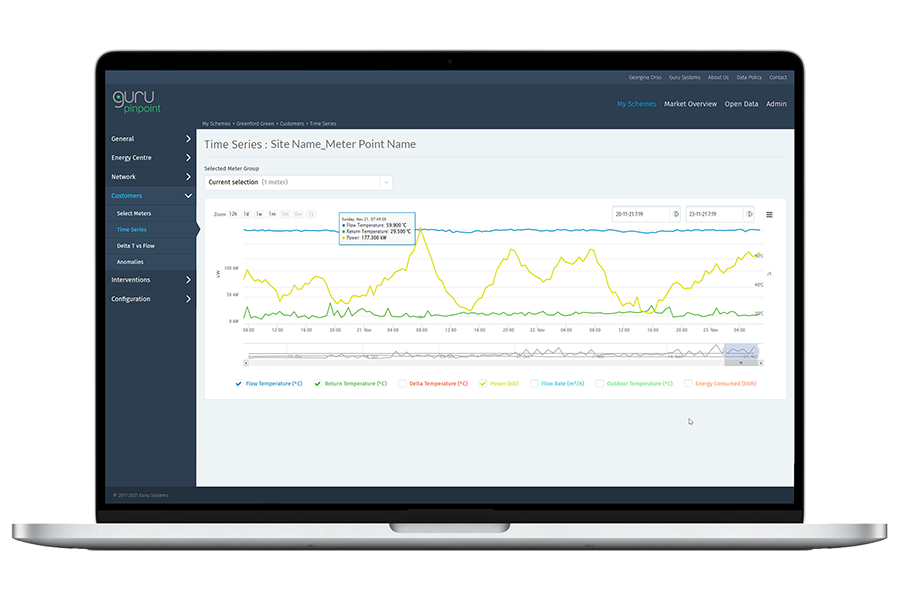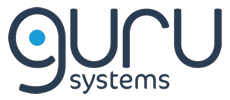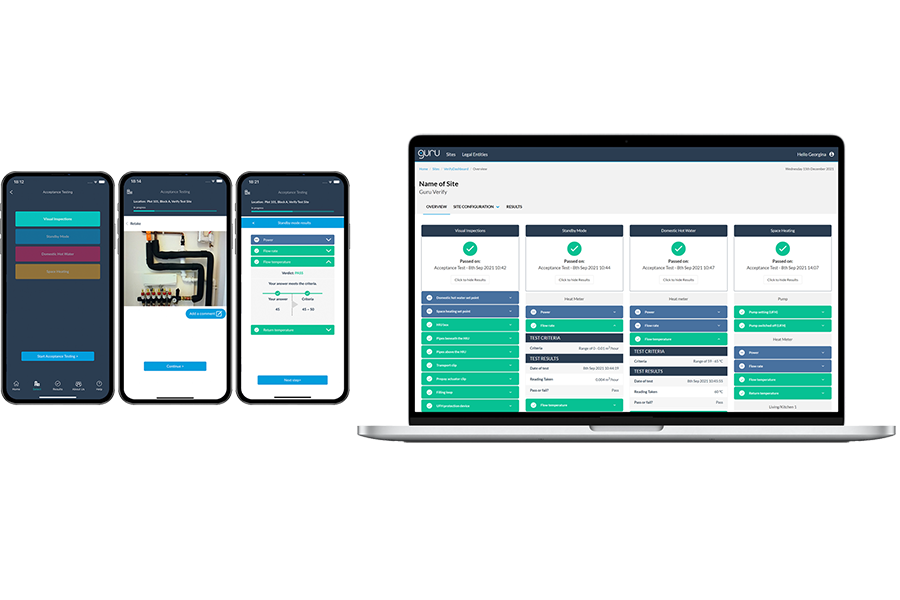The Heat Network Efficiency Scheme (HNES) is a £32m grant funding scheme to improve the performance of existing heat networks.
Guru Systems supported six projects as part of the previous HNES Demonstrator, and in this article we share case studies from two of those projects as well as covering the main details of the current Scheme.
In this article we cover:
- What is the Heat Network Efficiency Scheme (HNES)?
- Guru Systems and the HNES Demonstrator – including case studies
- How Guru Systems technology can support your HNES reporting requirements
- What kind of heat networks will qualify for HNES funding?
- What can HNES funding be used for?
- Acceptance testing and HNES
- Deadlines
HNES is a £32m grant funding scheme to improve the performance of existing heat networks.
Funding to deliver targeted and cost-effective performance improvements, or complete optimisation studies to identify costed and cost-effective performance improvement measures is available to local authorities, housing associations, private developers, public sector organisations and charities in England and Wales from February 2023.
This two year scheme (2023-2025) builds on the HNES Demonstrator that ran in 2021/22.
Guru Systems technology was installed on six sites as part of the Demonstrator. In this article we share our learnings so far, as well as a summary of how to use HNES to improve your existing heat networks.
Guru Systems captures performance data from over 250 heat networks in the UK, and over the past ten years we’ve worked with a wide range of local authorities, housing associations and private developers to support them as they improve the performance of their heat networks, and help to reduce costs for residents.
We drew on this experience to support six projects as part of the HNES Demonstrator.
HNES capital funding was used to install either Guru Hub 2 or Guru Hub 3 to capture performance data, and all projects then used Guru Pinpoint to identify problems and inefficiencies. Data-led interventions were made, with results visible in the data.
Here are two examples of the impact of data-led improvements on our HNES funded projects.
Site 1: Before

This graph from Guru Pinpoint shows one dwelling before interventions and performance is very bad. It shows flow temperature (dark blue), return temperature (green) and flow rate (light blue) across one week. Here we can see that flow temperature and return temperature are almost identical, and base flow rate (where the grey line is shown) is 0.045m3/hr (45 litres), rising to nearly ten times that rate at different points across the week. A well performing dwelling might see around 4 litres of water per hour flowing through when in standby mode, but this dwelling is returning huge amounts of hot water to the plant room. Even if this dwelling was the only misbehaving dwelling (which sadly it wasn’t) then the cost to run this network and the subsequent tariffs charged to residents is likely to be much higher than it needed to be.
Site 1: After

Guru Pinpoint also shows a dwelling from the network where interventions had already taken place. Here we see much better performance. When the HIU is in standby mode (power at 0 kW) flow temperature (dark blue) and return temperature (green) is low, but when heat is demanded, flow temperature jumps to around 65°C and return temperature drops right down to near 20°C showing that lots of heat energy has been extracted, and cool water is flowing back to the plant room. This is exactly what you want to see.
Site 2: Before

The graph above shows another dwelling before interventions are made and again performance is very poor. Guru Pinpoint shows flow rate (light blue), flow temperature (dark blue) and return temperature (green) across one day. The values for flow temperature and return temperature are so close together that they almost appear as one line. By showing delta temperature (the difference between flow and return temperature) you can see that the difference is less than 0.5°C. This means return temperatures are far higher than they should be, leading to higher heat losses from the network, higher cost of heat to customers and higher carbon emissions from the plant room.
Site 2: After

After interventions were made, a similar trend is seen to Site 1. When heat is demanded (power in kW, shown in yellow), then flow temperatures rise to around 70°C but return temperatures are way down, around 25°C – exactly what you expect to see from a dwelling that’s performing well
One of the important differences between the Demonstrator and the main Scheme when it opens in February is the performance reporting requirements.
Successful HNES projects are subject to a variety of minimum reporting requirements – including reporting performance related KPIs for 24 months after all funding measures have been installed and commissioned.
| Project KPIs | To monitor network performance including impact of delivered measures (relative to baseline) | Quarterly (submission of 3 sets of monthly KPI data) | Start: first quarter end after funding award confirmed.
End: 24 months (eight quarters) after all funded measures have been installed and commissioned |
|---|
Section 1.2 in the Scheme guidance details what kind of performance related KPIs should be included:
“Suppliers will propose and quantify suitable metrics, targets and KPI’s for measuring Project operational performance, based upon previous experience of delivering similar work. The baselining must cover assessment of the whole network architecture, including plant room/energy centre, primary / secondary /tertiary network and customer interfaces.”
“KPI’s will be Project-specific, but the Supplier should aim to report against as many as possible of the following:
- Annual network carbon emissions (kg.CO2e)
- Carbon content of delivered heat (kg.CO2e/kWh)
- Annual fuel use (gas, electricity, other) (kWh)
- Overall network efficiency (gas in / heat out) (%)
- Network distribution efficiency (heat leaving energy centre / heat delivered) (%)
- Network distribution losses (broken down by primary, secondary and tertiary where possible) (kWh)
- Network heat losses (W/dwelling)
- Network flow and return temperatures (deg)
- Cost to operator of delivering heat to customer interfaces (p/kWh)
- Heat tariff paid by network customers (p/kWh [variable], £/day [fixed])
- Overheating (description / annual number of hours reduction)
- Service outages/interruptions, planned and unplanned (# in recent 12-month period)
- Service outages/interruptions, planned and unplanned (total no. hours in recent 12 month period)
- Other appropriate/relevant KPI’s or metrics as proposed by the Client to support assessment of performance of a heat network.”
Guru Systems can provide data to support these performance reporting requirements.

PERFORMANCE MANAGEMENT
Guru Pinpoint
Guru Hub 2 also captures heat network performance data every five minutes for analysis via our online analytics platform Guru Pinpoint. Guru Pinpoint uses machine learning algorithms to help you identify and resolve performance issues and improve the efficiency of your heat network.
In the scheme guidance, the Department for Business, Energy and Industrial Strategy (BEIS) note that “the cost-of-living crisis has resulted in additional pressures on energy tariffs for some heat network customers, particularly where networks operate at lower efficiencies and increasing fuel costs are passed through.”
As a result, HNES has been designed to prioritise support for residential heat networks where ‘customers in need’ live. For the purpose of the HNES, “customers in need” are defined as:
“Dwellings supplied heat/energy by a heat network, in which a resident or residents fall into any of the following categories (or equivalent) of status or accommodation type: social housing; low-income housing, customers in fuel poverty; extra care housing; care homes; supported housing”
Capital grant funding
The HNES budget for capital grant funding is up to £30m across FY23/24 and FY24/25) and covers grants to part-fund the delivery (installation) of eligible intervention/improvement measures. Capital grant funding can provide up to (but not including) 50% of eligible project costs (including non-recoverable VAT).
The guidance says:
“There is no upper or lower limit for capital grant funding bids; however, each capital grant funding application to the HNES will be assessed on its own merits, and funding awards will be made subject to budget availability. If the HNES is oversubscribed (for either revenue grants, capital grants, or both) funding awards will be prioritised competitively based on the assessment criteria scoring.”
Capital funding will cover interventions in any of the following four areas:
Category 1: Energy centre / plant room
Category 2: Primary / secondary distribution network
Category 3: Tertiary network
Category 4: Metering – HNES funding can cover the installation of meters and metering equipment if it improves operator knowledge of network performance or enables reporting of project performance. This means that Guru Systems hardware can be funded. Guru Hub 2 and Guru Hub 3 Core are part of what the guidance refers to as a smart solution. This provides an interface to metering and the ability to make use of energy performance data. It’s important to note that if the heat supplier is required to install heat meters under the Heat Network (Metering and Billing) Regulations (i.e. a cost effectiveness assessment shows it is economically viable to fit heat meters in line with the regulations), then funding from HNES for heat meters themselves will not be covered – however as Guru Systems hardware are part of a smart solution, HNES funding can cover this equipment.
The scheme guidance details exactly what is and isn’t covered within each of these categories.
Regardless of which type of interventions are expected to be covered, Guru Systems always argues that interventions should be data led, and that performance data should also be used to check that those interventions have been delivered correctly.
Heat networks consultancy FairHeat describe Acceptance Testing as ‘rigorous testing to verify dwelling performance by ensuring the installation, commissioning and operation are as per the design and performance specification’. In CP1 2020, minimum standards now require independent testing on a sample of dwellings in a building – although best practice is to test every dwelling.
At Guru Systems we advocate Acceptance Testing 100% of dwellings because in our experience it only takes one poorly performing HIU to flood a plant room with lots of hot water (as seen in the sites above).
While interventions may be meticulously planned, it’s important that any HNES funded projects can hold their contractors to account and ensure that every single dwelling is performing as expected, with outcomes verified.
Revenue grant funding for optimisation studies
The HNES budget for revenue funding is up to £2m across FY23/24 and FY24/25) and includes grants to fund procurement or mobilisation of external third-party support to carry out Optimisation Studies. These studies will assess heat network projects to identify causes of sub-optimal performance and recommend costed intervention or improvement measures.
Revenue grant funding for optimisation studies can provide up to 100% of eligible project costs and HNES will typically fund between £15,000 and £24,000 (incl. non-recoverable VAT) per project revenue (Optimisation Study) grant funding application, depending on the scale of each project for which the application is made.
Important note on funding which spans more than one financial year
BEIS state that:
“It is important to note that funding requests made to HNES may span across multiple years. For example, a request for £200,000 may be forecast to be spent over a 2-year period, currently up to March 2025. In a given financial year (April-March), all applicants must have carried out works up to the value of the grant awarded within that given financial year. Failure to do so may result in the loss of a portion of the total grant awarded.”
Note: It’s not necessary to have done an optimisation study before applying for capital works, but it can help.
HNES split into eight funding rounds. The final application submission date for inclusion in each funding round is as follows:
- Round 1 Friday 31st March 2023
- Round 2 Friday 19th May 2023
- Round 3 Friday 7th July 2023
- Round 4 Friday 25th August 2023
- Round 5 Friday 13th October 2023
- Round 6 Friday 2nd February 2024
- Round 7 Friday 22nd March 2024
- Round 8 Friday 10th May 2024
What is the HNES assessment criteria?
Section 1.3 in the Scheme guidance document details how applications will be assessed.
Our next webinar, ‘Sharing best practice from the Heat Network Efficiency Scheme Demonstrator’ will be held on Friday 24th February at 11am. You are able to sign-up here.
Request a meeting with the Guru Systems team
Guru Systems is happy to talk in more detail about the projects we’ve supported under the HNES Demonstrator, and previous optimisation projects we’ve been involved in.
To find out more, enter your details below and we’ll get back to you.


